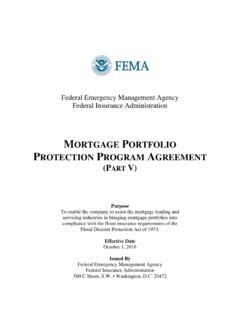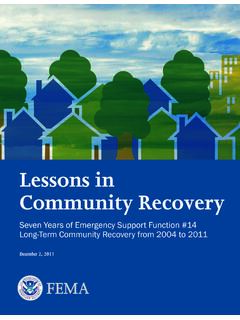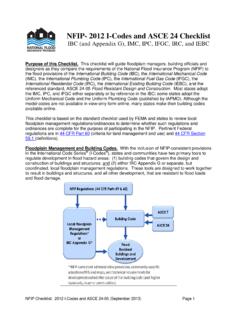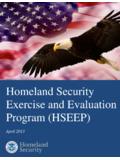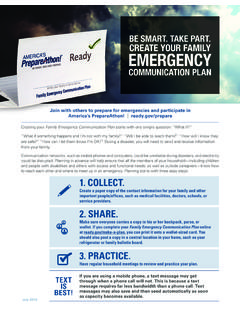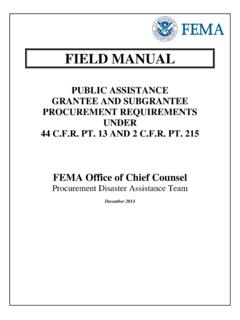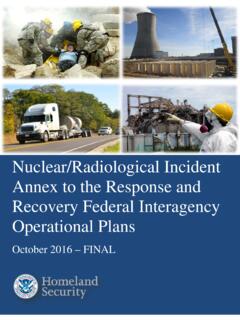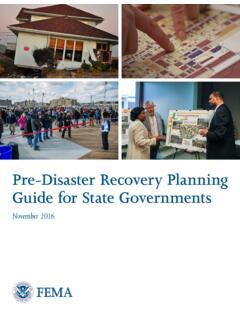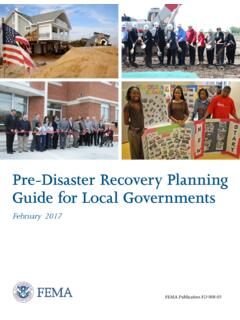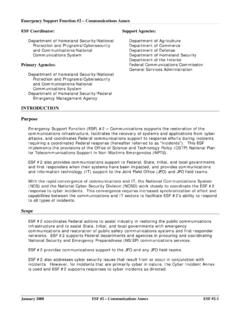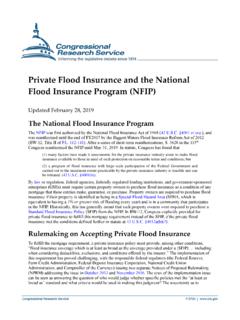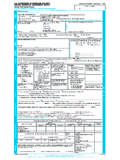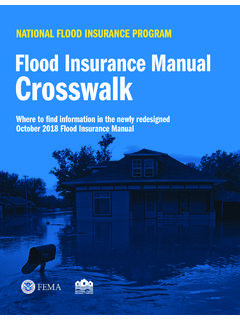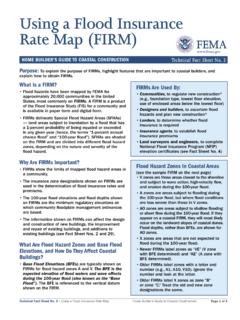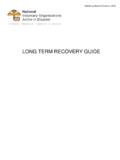Transcription of National Flood Insurance Program Fact Sheet - FEMA.gov
1 fema s mission is to support our citizens and first responders to ensure that as a nation we work together to build, sustain, and Improve our ca-pability to prepare for, protect against, respond to, recover from, and mitigate all hazards. Federal Insurance and Mitigation Administration Page 1 of 2 The National Flood Insurance Program (NFIP) was established with the passage of the National Flood Insurance Act of 1968. The NFIP is a federal pro-gram enabling property ownersin participating communities to purchase Flood Insurance as pro-tection against Flood losses, while requiring state and local governments to enforce floodplain man-agement ordinances that aim to reduce future Flood damage. More than 22,100 communities in the participating in the NFIP and more than million NFIP policies in force, providing $ tril-lion of content and building coverage. Financial Protection Against Flood Loss floods are the most common and costly natural disaster in the United States. Fortunately, property owners who live in communities participating in the NFIP can pur-chase affordable protection to insure against Flood losses.
2 Since 1978, the NFIP has paid nearly $ bil-lion dollars in Flood Insurance claims that have helped hundreds of thousands of families and businesses re-cover from Flood events. To participate in the NFIP, a community must adopt and enforce floodplain management ordinances that meet or exceed the minimum requirements of the Pro-gram. These requirements are intended to prevent loss of life, loss of property, reduce taxpayer costs for dis-aster relief, as well as minimize economic and social hardships that result from flooding. The specific re-quirements that a community must adopt depend on the type of Flood hazard faced by the community. The NFIP has an arrangement with private Insurance companies to sell and service Flood Insurance policies. See a list of those companies at: Myths and Misconceptions A common misconception is that homeowners policies cover Flood damage. In fact , most homeowner . In fact , most homeowner and business multi peril policies do not cover flooding.
3 In addition, federal disaster assis-tance will not always pay for Flood damage. The Presi-dent must declare a major disaster before most forms of federal disaster assistance can be offered and most forms of disaster assistance are loans that must be re-paid with interest. In 2016, the average Flood policy costs about $700 a year and the average total paid claim has been more than $31,000. Everyone Needs Flood Insurance While Flood Insurance is not mandatory for home-owners outside of a high-risk area, anyone can be fi-nancially vulnerable to floods . People outside of high-risk areas file more than 20 percent of NFIP claims and receive one-third of disaster assistance for Flood -ing. Residential and commercial property owners who are not located in high-risk areas should ask their agents if they are eligible for the Preferred Risk Poli-cy, which provides affordable Flood Insurance protec-tion, starting as low as $137 a year in 2016. National Flood Insurance Program fact Sheet Andrea Booher/ fema Photo fema s mission is to support our citizens and first responders to ensure that as a nation we work together to build, sustain, and Improve our ca-pability to prepare for, protect against, respond to, recover from, and mitigate all hazards.
4 Federal Emergency Management Agency National Flood Insurance Program fact Sheet Page 2 of 2 Flood Insurance Requirements Residents and business owners who own property in high-risk areas (sometimes referred to asSpecial Flood Haz-ard Areas [SFHAs]) are required to purchase Flood Insurance if they have a mortgage from a federally regulated or insured lender. They also must carry the Insurance forthe life of the mortgage. Residents and business owners with a mortgage on a building outsidehigh-risk areas can also purchase Flood Insurance and may be eligible for lower-cost PreferredRisk Policies. Waiting Period In general, a policy does not take effect until 30 days after the purchase of Flood , if a policy is pur-chased in connection with making, increasing, extending, orrenewing a loan there is no waiting period and only a one day waiting period if purchase isrelated to the revision or update of a Flood Insurance Rate Map (FIRM) within 13 months ofthe new FIRM s effective date.
5 What Is Not Covered by Flood Insurance Physical damage to a building or personal possessions that are directly caused by a Flood aregenerally covered by Flood Insurance . For example, damage caused by a sewer backup iscovered if the backup is a direct result of flooding. However, if the backup is caused by someother problem, the damage is not covered. The Flood Insurance Program is Evolving The NFIP is focusing making America truly Flood Smart. The NFIP is a comprehensive Program that encourages property owners to seriously consider their risks and ways they can lessen those risks and Flood Insurance is obviously a key component. Purchasing Flood Insurance is still the most powerful action survivors can take to mitigate the financial risk of Flood before and recover after a Flood event. Flood Insurance is both a mitigation and recovery tool. This means customers need to understand how Flood Insurance works, the value of the product, and be able to navigate processes like the claims process.
6 In addition to building trust with policyholders, improving communication and making processes simpler to un-derstand and navigate, the NFIP is also focusing on its commitment to strengthening partnerships and engage-ments with communities. Historically, with things like Climate Change occurring, and population movements into Flood -prone areas, floodplain management has never been more important. Communities must make excellent decisions that will help them reduce damage from future Flood events and the NFIP is supporting them in new, innovative ways. For Additional Information For additional information about the NFIP or the FloodSmart campaign, visit.
